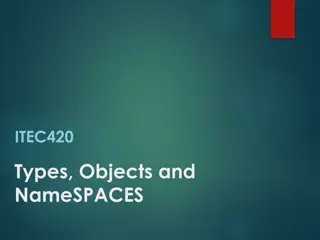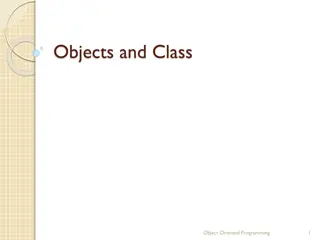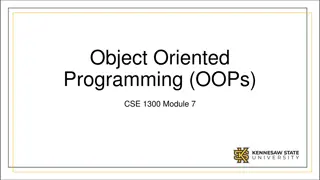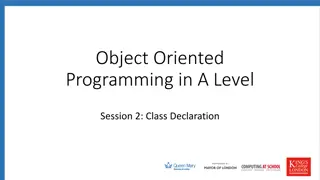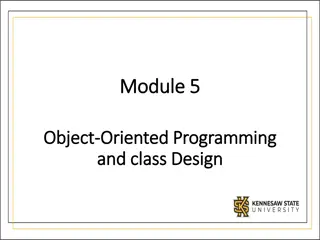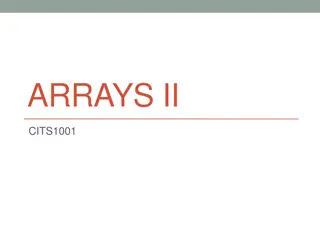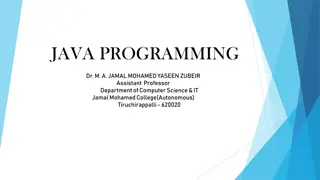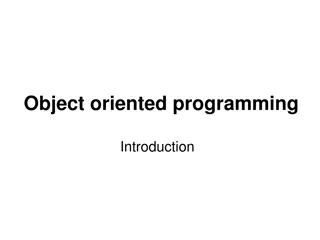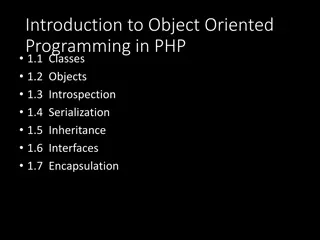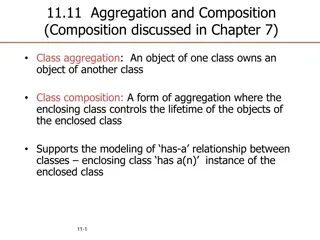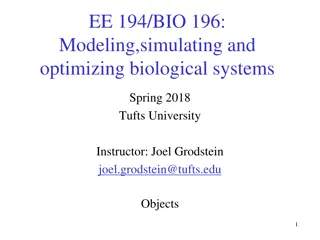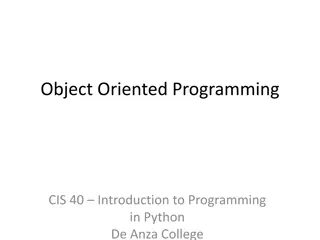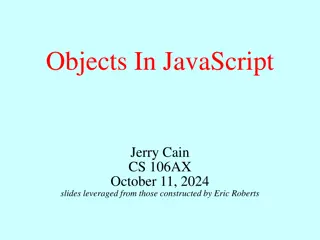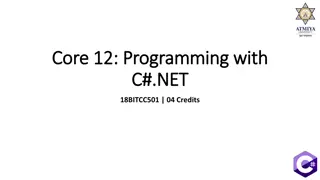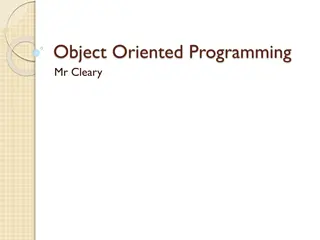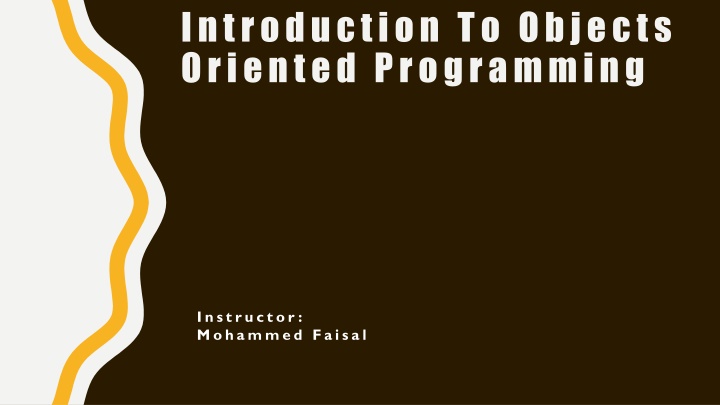
Object-Oriented Programming Concepts
Dive into the world of Object-Oriented Programming with this comprehensive introduction. Learn about objects, classes, constructors, and more. Understand how to define objects in code and give them behaviors and states, mirroring real-world entities.
Download Presentation

Please find below an Image/Link to download the presentation.
The content on the website is provided AS IS for your information and personal use only. It may not be sold, licensed, or shared on other websites without obtaining consent from the author. If you encounter any issues during the download, it is possible that the publisher has removed the file from their server.
You are allowed to download the files provided on this website for personal or commercial use, subject to the condition that they are used lawfully. All files are the property of their respective owners.
The content on the website is provided AS IS for your information and personal use only. It may not be sold, licensed, or shared on other websites without obtaining consent from the author.
E N D
Presentation Transcript
Introduction To Objects Oriented Programming Instructor : Mohammed Faisal
Lecture 1 Introduction to OOP Concepts. Objects Classes Contractures Examples Lecture 2 AGENDA
OO Programming Concepts An Object-oriented programming (OOP) involves programming using objects. Object represents an entity in the real world that can be distinctly identified. For example, a student, a car, a circle.. 3
OO Programming Concepts (con.) Car Number An object has a unique: Identity State Behaviors. The state of an object consists of a set of datafields (also known as properties) with their current values. The behavior of an object is defined by a set of methods. Color Switch on 4
Objects A class template Class Name: Circle Data Fields: radius is _______ Methods: getArea Three objects of the Circle class Circle Object 2 Data Fields: radius is 25 Circle Object 3 Data Fields: radius is 125 Circle Object 1 Data Fields: radius is 10 An object has both a state and behavior. The state defines the object, and the behavior defines what the object does. 5
Classes Classes are constructs that define objects of the same type. A Java class uses variables to define data fields and methods to define behaviors. Additionally, a class provides a special type of methods, known as constructors, which are invoked to construct objects from the class. 6
Classes class Circle { /** The radius of this circle */ double radius = 1.0; /** Construct a circle object */ Circle() { } /** Construct a circle object */ Circle(double newRadius) { radius = newRadius; } /** Return the area of this circle */ double getArea() { return radius * radius * 3.14159; } } Data field Constructors Method 7
Constructors Constructors are a special kind of methods that are invoked to construct objects. Circle() { } Circle(double newRadius) { radius = newRadius; } 8
Constructors, cont. A constructor with no parameters is referred to as a no- arg constructor. Constructors must have the same name as the class itself. Constructors do not have a return type not even void. Constructors are invoked using the new operator when an object is created. Constructors play the role of initializing objects. 9
Creating Objects Using Constructors new ClassName(); Example: new Circle(); new Circle(5.0); 10
Default Constructor A class may be defined without constructors. In this case, a no-arg constructor with an empty body is implicitly defined in the class. This constructor, called a default constructor, is provided automatically only if no constructors are explicitly defined in the class. 11
Declaring Object Reference Variables To reference an object, assign the object to a reference variable. To declare a reference variable, use the syntax: ClassName objectRefVar; Example: Circle myCircle; 12
Declaring/Creating Objects in a Single Step ClassName objectRefVar = new ClassName(); Create an object Assign object reference Example: Circle myCircle = new Circle(); 13
Accessing Objects Members Referencing the object s data: objectRefVar.data e.g., myCircle.radius Invoking the object s method: objectRefVar.methodName(arguments) e.g., myCircle.getArea() 14
Example: Defining Classes and Creating Objects Objective: Demonstrate creating objects, accessing data, and using methods. Animation Animation Run Run TestSimpleCircle 15
Example: Defining Classes and Creating Objects TV The current channel (1 to 120) of this TV. The current volume level (1 to 7) of this TV. Indicates whether this TV is on/off. Constructs a default TV object. Turns on this TV. Turns off this TV. Sets a new channel for this TV. Sets a new volume level for this TV. Increases the channel number by 1. Decreases the channel number by 1. Increases the volume level by 1. Decreases the volume level by 1. channel: int volumeLevel: int on: boolean +TV() +turnOn(): void +turnOff(): void +setChannel(newChannel: int): void +setVolume(newVolumeLevel: int): void +channelUp(): void +channelDown(): void +volumeUp(): void +volumeDown(): void The + sign indicates a public modifier. TV Run Run TestTV 16
Trace Code Declare myCircle Circle myCircle = new Circle(5.0); no value myCircle Circle yourCircle = new Circle(); yourCircle.radius = 100; 17
Trace Code, cont. Circle myCircle = new Circle(5.0); no value myCircle Circle yourCircle = new Circle(); : Circle yourCircle.radius = 100; radius: 5.0 Create a circle 18
Trace Code, cont. Circle myCircle = new Circle(5.0); reference value myCircle Circle yourCircle = new Circle(); Assign object reference to myCircle : Circle yourCircle.radius = 100; radius: 5.0 19
Trace Code, cont. Circle myCircle = new Circle(5.0); reference value myCircle Circle yourCircle = new Circle(); : Circle yourCircle.radius = 100; radius: 5.0 no value yourCircle Declare yourCircle 20
Trace Code, cont. Circle myCircle = new Circle(5.0); reference value myCircle Circle yourCircle = new Circle(); : Circle yourCircle.radius = 100; radius: 5.0 no value yourCircle : Circle radius: 1.0 Create a new Circle object 21
Trace Code, cont. Circle myCircle = new Circle(5.0); reference value myCircle Circle yourCircle = new Circle(); : Circle yourCircle.radius = 100; radius: 5.0 reference value yourCircle Assign object reference to yourCircle : Circle radius: 1.0 22
Trace Code, cont. Circle myCircle = new Circle(5.0); reference value myCircle Circle yourCircle = new Circle(); yourCircle.radius = 100; : Circle radius: 5.0 reference value yourCircle : Circle radius: 100.0 Change radius in yourCircle 23
Reference Data Fields The data fields can be of reference types. For example, the following Student class contains a data field name of the String type. public class Student { String name; // name has default value null int age; // age has default value 0 boolean isScienceMajor; // isScienceMajor has default value false char gender; // c has default value '\u0000' } 24
The Null Value If a data field of a reference type does not reference any object, the data field holds a special literal value, null. 25
Default Value for a Data Field The default value of a data field is null for a reference type, 0 for a numeric type, false for a boolean type, and '\u0000' for a char type. However, Java assigns no default value to a local variable inside a method. public class Test { public static void main(String[] args) { Student student = new Student(); System.out.println("name? " + student.name); System.out.println("age? " + student.age); System.out.println("isScienceMajor? " + student.isScienceMajor); System.out.println("gender? " + student.gender); } } 26
Example Java assigns no default value to a local variable inside a method. public class Test { public static void main(String[] args) { int x; // x has no default value String y; // y has no default value System.out.println("x is " + x); System.out.println("y is " + y); } } Compile error: variable not initialized 27
Differences between Variables of Primitive Data Types and Object Types Created using new Circle() Primitive type int i = 1 i 1 c: Circle radius = 1 Object type Circle c c reference 28
Copying Variables of Primitive Data Types and Object Types Primitive type assignment i = j Before: After: i 1 i 2 j 2 j 2 Object type assignment c1 = c2 Before: After: c1 c1 c2 c2 C2: Circle radius = 9 c1: Circle radius = 5 C2: Circle radius = 9 c1: Circle radius = 5 29
The Date Class Java provides a system-independent encapsulation of date and time in the java.util.Date class. You can use the Date class to create an instance for the current date and time and use its toString method to return the date and time as a string. java.util.Date The + sign indicates public modifer +Date() +Date(elapseTime: long) Constructs a Date object for the current time. Constructs a Date object for a given time in milliseconds elapsed since January 1, 1970, GMT. Returns a string representing the date and time. Returns the number of milliseconds since January 1, 1970, GMT. Sets a new elapse time in the object. +toString(): String +getTime(): long +setTime(elapseTime: long): void 30
The Date Class Example For example, the following code java.util.Date date = new java.util.Date(); System.out.println(date.toString()); displays a string like Sun Mar 09 13:50:19 EST 2003. 31
Lecture 2 32
Instance Variables, And Methods Instance variables belong to a specific instance. Instance methods are invoked by an instance of the class. 33
Static Variables, Constants, and Methods Static variables are shared by all the instances of the class. In this context, static means that the variable, constant, or method belongs to the class. Static methods are not tied to a specific object. Static constants are final variables shared by all the instances of the class. 34
Static Variables, Constants, and Methods, cont. To declare static variables, constants, and methods, use the static modifier. static int NumberOfObject = 0; static final int PI = 3.14; 35
Static Variables, Constants, and Methods, cont. 36
Example of Using Instance and Class Variables and Method Objective: Demonstrate the roles of instance and class variables and their uses. This example adds a class variable numberOfObjects to track the number of Circle objects created. CircleWithStaticMembers Run Run TestCircleWithStaticMembers 37
Visibility Modifiers and Accessor/Mutator Methods By default, the class, variable, or method can be accessed by any class in the same package. public The class, data, or method is visible to any class in any package. private The data or methods can be accessed only by the declaring class. The get and set methods are used to read and modify private properties. 38
The private modifier restricts access to within a class, the default modifier restricts access to within a package, and the public modifier enables unrestricted access. 39
NOTE An object cannot access its private members, as shown in (b). It is OK, however, if the object is declared in its own class, as shown in (a). 40
Why Data Fields Should Be private? To protect data. To make code easy to maintain. 41
Example of Data Field Encapsulation Circle The radius of this circle (default: 1.0). The number of circle objects created. Constructs a default circle object. Constructs a circle object with the specified radius. Returns the radius of this circle. Sets a new radius for this circle. Returns the number of circle objects created. Returns the area of this circle. The - sign indicates private modifier -radius: double -numberOfObjects: int +Circle() +Circle(radius: double) +getRadius(): double +setRadius(radius: double): void +getNumberOfObjects(): int +getArea(): double CircleWithPrivateDataFields Run Run TestCircleWithPrivateDataFields 42
Passing Objects to Methods Passing by value for primitive type value (the value is passed to the parameter) Passing by value for reference type value (the value is the reference to the object) Run Run TestPassObject 43
Array of Objects Circle[] circleArray = new Circle[10]; An array of objects is actually an array of reference variables. So invoking circleArray[1].getArea() involves two levels of referencing as shown in the next figure. circleArray references to the entire array. circleArray[1] references to a Circle object. 45
Array of Objects, cont. Circle[] circleArray = new Circle[10]; 46
Array of Objects, cont. Summarizing the areas of the circles Run Run TotalArea 47
Immutable Objects and Classes If the contents of an object cannot be changed once the object is created, the object is called an immutable object and its class is called an immutable class. If you delete the set method in the Circle class, the class would be immutable because radius is private and cannot be changed without a set method. A class with all private data fields and without mutators is not necessarily immutable. For example, the following class Student has all private data fields and no mutators, but it is mutable. 48
Example public class BirthDate { private int year; private int month; private int day; public BirthDate(int newYear, int newMonth, int newDay) { year = newYear; month = newMonth; day = newDay; } public void setYear(int newYear) { year = newYear; } } public class Student { private int id; private BirthDate birthDate; public Student(int ssn, int year, int month, int day) { id = ssn; birthDate = new BirthDate(year, month, day); } public int getId() { return id; } public BirthDate getBirthDate() { return birthDate; } } public class Test { public static void main(String[] args) { Student student = new Student(111223333, 1970, 5, 3); BirthDate date = student.getBirthDate(); date.setYear(2010); // Now the student birth year is changed! } } 49
What Class is Immutable? For a class to be immutable, it must mark all data fields private and provide no mutator methods and no accessor methods that would return a reference to a mutable data field object. 50

